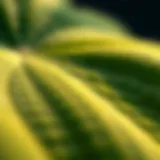Wildflower Natural Medicine: Integrating Flora into Wellness Practices


Intro
Wildflower natural medicine has gained significant attention in recent years. Yet, its roots can be traced back through history, where diverse flora played a pivotal role in various cultures' health practices. Understanding this intricate relationship between humans and wildflowers can enhance contemporary wellness approaches. This article unfolds the multifaceted world of wildflower medicine, examining its historical significance, current applications, and the ethical considerations surrounding its use.
The increasing interest in natural remedies has sparked a renewed exploration of wildflowers as potent sources of healing compounds. Each species brings unique properties, which can be harnessed in various ways, from teas and tinctures to topical applications. However, this journey into the realm of flora is not just about individual plants. It encompasses broader themes of sustainability and responsible foraging practices.
This article aims to illuminate the pathways linking natural ecosystems with wellness. As we delve deeper, we will uncover vital information regarding specific wildflowers and their healing potential. Additionally, we will address the importance of preserving the biodiversity of natural habitats to ensure future access to these beneficial plants.
Preamble to Wildflower Natural Medicine
Wildflower natural medicine has emerged as a significant aspect of holistic health and wellness. Understanding the integration of flora into wellness practices can enhance one's appreciation of the natural world. This understanding fosters a connection between humans and the environment, showing how plants can contribute to health solutions.
In this article, we delve into this multifaceted topic. We will explore historical perspectives, cultural significance, and the scientific underpinnings that inform this practice. By examining these elements, we gain a more nuanced view of how wildflowers can be leveraged for medicinal purposes.
Incorporating wildflower medicine into one’s health routine holds several benefits:
- Natural Resource: Wildflowers often serve as readily available resources for many individuals seeking alternative health solutions.
- Holistic Approach: The use of wildflowers addresses not only physical ailments but also mental and emotional well-being.
- Cultural Relevance: Different cultures recognize the significance of certain wildflowers, creating diverse contexts for their use in medicine.
However, there are also considerations to keep in mind when discussing wildflower natural medicine. Ethical sourcing and proper identification of species are crucial. Not all wildflowers are safe for consumption, and some may interact adversely with medications. As we explore this topic, we prioritize factual information and responsible practices to ensure safe use.
"The relationship between humans and wildflowers is intricate and profound. It impacts health, culture, and ecosystem sustainability."
Overall, this section lays the groundwork for understanding wildflower natural medicine’s broader implications. By the end of this article, readers will not only know about various wildflower species but will also understand their roles in historical and modern medicinal practices.
Key Wildflower Species in Natural Medicine
Understanding specific wildflower species is crucial in the realm of natural medicine. Each plant carries unique properties, compounds, and benefits vital to wellness practices. By delving into these species, individuals learn to harness nature’s healing potential effectively. This segment will highlight key wildflower species and their applications in natural medicine, addressing their benefits and practical considerations.
Echinacea: Immunity Booster
Active Compounds
Active compounds in Echinacea, such as alkamides and polysaccharides, play an essential role in enhancing immune function. These components activate immune cells, which may help in resisting infections. The key characteristic of Echinacea lies in its ability to stimulate the immune system, making it highly popular among herbal remedies. However, it is important to note that the specific effects can vary based on the preparation and individual response. This variability may require some experimentation to find the optimal use for personal health.
Preparation Methods
Preparation of Echinacea can range from teas to tinctures. Each method extracts different concentrations of active compounds. Infusions often provide a milder effect, while tinctures offer a more concentrated dose. This versatility is a beneficial trait, allowing practitioners to cater to specific preferences and needs. However, careful attention is required to maintain the efficacy of the active compounds, as prolonged exposure to heat may degrade their potency.
Dosage Guidelines
Dosage of Echinacea can vary depending on the form used. For teas, 1-2 grams of dried root or flower per 8 ounces of water is often recommended. Tinctures may require different dosages, typically between 20 to 40 drops, three to four times daily. These guidelines are beneficial, promoting safe and effective use. However, it is crucial to adjust dosages based on individual health conditions and consult with healthcare providers when necessary.
Chamomile: Calming Effects
Healing Properties
Chamomile exhibits powerful healing properties, particularly in promoting relaxation and reducing anxiety. The essential oils and flavonoids contribute to its anti-inflammatory and antispasmodic effects. This quality makes chamomile a favored choice for those seeking natural remedies for stress and sleep disorders. However, it is essential to note that chamomile may not be suitable for everyone, especially individuals with allergies to related plants such as ragweed.
Common Uses
Chamomile is frequently used as a calming tea, but can also be found in extracts and topical applications. These diverse methods enhance its accessibility for various health needs. The broad usage reflects its beneficial adaptations to multiple conditions, such as digestive issues and skin irritations. Nevertheless, users should remain mindful of potential interactions with medications, which could affect its efficacy.
Possible Side Effects
While chamomile is generally considered safe, some individuals may experience allergic reactions or drowsiness. Affected persons should monitor their responses and consult healthcare professionals if any adverse symptoms arise. This caution emphasizes the importance of understanding personal health histories when incorporating new herbal therapies into one’s routine.
Lavender: Aromatic Healing
Therapeutic Benefits
Lavender is renowned for its therapeutic benefits, especially in reducing anxiety and improving sleep quality. Key components like linalool and linalyl acetate contribute significantly to these effects. Its calming aroma interacts with the body's physiological systems, making it a popular choice in aromatherapy. This property makes lavender essential in holistic health practices. However, its effects can vary based on individual sensitivities, necessitating a tailored approach.
Application Techniques
Lavender can be utilized through essential oils, teas, or sachets. Essential oils can be diffused, applied topically, or added to baths. This variety provides numerous options for integration into daily routines. Each method has its own advantages, but it is crucial to use high-quality oils to ensure the best results. Improper use or low-quality products may lead to reduced efficacy.
Cautions
While lavender is generally safe, caution is necessary for those with allergies or hormone-sensitive conditions. The potential for hormonal effects, particularly with excessive use, warrants careful consideration. Users should approach lavender thoughtfully, weighing its benefits against any possible personal health implications.
St. John's Wort: Mood Stabilizer
Chemical Constituents
St. John's Wort contains hypericin and hyperforin, which are key to its mood-stabilizing properties. Research suggests these constituents may elevate serotonin levels, impacting mood regulation. This characteristic makes it popular among those seeking natural solutions for mild to moderate depression. However, varying responses to these compounds underline the need for personalized approaches when incorporating them into wellness routines.


Forms of Use
St. John's Wort is available in capsules, teas, and topical applications. Each form offers unique benefits, with capsules providing concentrated doses for long-term use while teas promote relaxation. The diverse application methods cater to individual preferences but require careful monitoring of effects to ensure safe usage.
Interaction with Other Medications
St. John’s Wort is notorious for interacting with various medications, particularly antidepressants and birth control pills. This interaction can diminish the effectiveness of prescription drugs, posing potential risks. Therefore, individuals should consult healthcare providers before use, ensuring a safe and informed approach to integrating this herb into their wellness practices.
Dandelion: Nutritional Powerhouse
Health Benefits
Dandelion possesses an array of health benefits, including supporting liver function and digestion. Rich in vitamins and minerals, it is often compared to more common vegetables in terms of nutritional density. This key characteristic establishes dandelion as a valuable addition to natural medicine. However, its bitter taste may deter some individuals, requiring creative culinary approaches to embrace its advantages.
Using Dandelion in Diet
Dandelion can be used in salads, teas, or as a supplement in various meals. Its greens are rich in nutrients and can be a delightful addition to recipes, enhancing overall health. This versatile use emphasizes dandelion's role in promoting a balanced diet. Individuals new to this herb may need time to adjust to its flavor, underscoring the importance of gradual incorporation.
Foraging Ethics
Foraging dandelions requires ethical consideration to preserve local ecosystems. Sustainable harvesting methods ensure that populations remain healthy and viable. This key feature underscores the significance of responsible practices in wildflower medicine. Understanding local regulations and community guidelines is essential to protect both the herb and the environment.
Ethical foraging not only preserves plant populations but also fosters respect for the land we use for natural wellness.
Mechanisms of Action: How Wildflowers Affect Health
Understanding the mechanisms through which wildflowers influence health is crucial to appreciating their role in natural medicine. This section focuses on three key aspects: phytochemistry, synergistic effects of plant compounds, and their impact on inflammation and immune response. By examining these factors, we can gain insight into the potential benefits and applications of wildflowers in holistic health practices.
Phytochemistry and Human Health
Phytochemistry explores the chemical compounds present in plants, including wildflowers. An in-depth understanding of these compounds is essential, as they form the groundwork for the medicinal properties of various species. Wildflowers contain a plethora of bioactive substances such as alkaloids, flavonoids, and terpenes. These compounds have been studied for their ability to promote human health through various mechanisms.
For example, Echinacea contains compounds that enhance the immune function, while Chamomile is known for its anti-inflammatory properties. Research suggests that certain phytochemicals can interact with the body’s systems, leading to beneficial effects. This relationship between phytochemistry and health represents a critical area of study within wildflower natural medicine.
Synergistic Effects of Plant Compounds
A notable aspect of wildflower natural medicine is the synergistic effects that arise from the interaction of multiple plant compounds. Rather than acting in isolation, these compounds often work collectively to enhance therapeutic effects. This phenomenon is referred to as the entourage effect, which can bolster the efficacy of individual elements within a wildflower.
For instance, the combination of various constituents in St. John's Wort has been shown to effectively support mood stabilization. When integrated into practices like herbal preparations, the dynamic interplay between these compounds can lead to improved outcomes over isolated compounds. This underscores the significance of using whole plants rather than isolated extracts in natural medicine applications.
Impacts on Inflammation and Immune Response
Understanding how wildflowers impact inflammation and the immune response is vital to evaluating their therapeutic potential. Inflammation is a natural response in the body to injury or infection, but chronic inflammation can lead to various health issues. Many wildflowers possess anti-inflammatory properties that can help mitigate these effects.
Lavender, for example, is notable for its calming effects, often used to reduce anxiety levels which can also lead to inflammatory responses. Moreover, certain wildflower species enhance immune response, helping the body to fight pathogens more effectively.
Wildflowers such as Dandelion have been recognized for their ability to support liver health and detoxification processes as well. Their multifaceted impacts on inflammation and immune regulation make them valuable tools in natural health paradigms.
"The synergy among the compounds found in wildflowers enhances the effectiveness of natural medicine and opens new avenues in health management."
By delving into the mechanisms of action associated with wildflowers, we can fully appreciate their role in enhancing well-being. Continued research into these elements will contribute significantly to advancing our understanding of how these plants can be effectively utilized in holistic health practices.
Practical Applications in Natural Medicine
The integration of wildflowers into natural medicine offers a broad spectrum of practical applications that can enhance well-being and support various health practices. Understanding these applications is crucial for professionals and individuals seeking to employ these natural remedies effectively. Wildflower-derived preparations can be aligned with holistic health philosophies and serve as a complement to traditional medicine. This section will explore the methods of creating herbal preparations, dosing protocols, and the incorporation of wildflowers into daily health routines.
Creating Herbal Preparations
Infusions and Decoctions
Infusions and decoctions are fundamental methods for harvesting the benefits of wildflowers.
- Infusions involve steeping flowers, leaves, or herbs in hot water. This method captures readily soluble compounds, making it an excellent way to extract flavors and medicinal properties from delicate flowers like chamomile.
- Decoctions are commonly used for harder plant materials, such as roots or seeds, boiled for a longer period to draw out more complex compounds.
Both methods allow for a heightened bioavailability of active components, enhancing their therapeutic effects. Their ease of preparation makes them a popular choice among herbalists.
"The choice between infusion and decoction can significantly alter the medicinal outcomes, as some compounds are water-soluble while others require heat for extraction."
The notable advantage of these methods lies in their accessibility, enabling practitioners to quickly create beneficial herbal concoctions from locally sourced wildflowers.
Tinctures and Extracts
Tinctures and extracts offer a concentrated means of utilizing the medicinal properties of wildflowers. Tinctures are alcohol-based solutions that extract compounds from plant materials. This method preserves the active ingredients more effectively than other preparations.
- Extracts may involve using glycerin or other solvents instead of alcohol, often appealing to those who prefer non-alcoholic options.


The potency of tinctures allows for precise dosing, often making them a preferred choice for those seeking specific therapeutic effects. Their long shelf life is another significant benefit, although the alcohol content can be a disadvantage for certain individuals.
Topical Applications
The application of wildflowers through topical preparations is gaining recognition in natural medicine.
- This method includes essential oils, salves, and herbal creams derived from wildflowers like lavender. The key characteristic of topical applications is their targeted delivery, as they can promote localized relief of issues such as inflammation or skin conditions.
- A unique feature is the rapid onset of effects, as these preparations bypass systemic circulation, acting directly at the site of application.
While the effects can be potent, caution is necessary. Sensitive individuals may experience reactions to topical applications, necessitating patch tests before broader use.
Dosing and Administration
Recommended Dosages
Understanding recommended dosages is crucial for maximizing the benefits of wildflowers while minimizing risks. Each wildflower has distinct active compounds that require careful consideration to achieve therapeutic effects safely.
- Typically, herbalists rely on established guidelines and traditional knowledge when determining dosages. The key characteristic of recommended dosages is the balance of effectiveness with safety, emphasizing individualized approaches.
- The unique aspect of herbal medicine is that it often requires adjustments based on individual responses and health conditions, which can complicate standardization.
Frequency of Use
The frequency of use is another important factor in the practical application of wildflower natural medicines. Sustained use may be necessary to reap cumulative benefits, particularly in conditions requiring long-term management, such as anxiety and inflammation.
- This characteristic aligns with the holistic approach of natural medicine, where consistency often leads to improved results.
- However, overuse can lead to unwanted side effects or decreased efficacy, highlighting the necessity for educated guidance on frequency.
Monitoring Effects
Monitoring effects is essential for ensuring the safety and success of incorporating wildflowers into health routines.
- Regular self-assessment allows users to evaluate the effectiveness of chosen remedies, identifying both positive responses and any potential adverse effects.
- This process encourages a reflective practice, aligning with the overall ethos of personalized natural medicine. However, some may find it challenging to accurately assess effects without appropriate benchmarks or support.
Incorporating Wildflowers into Health Routines
Daily Practices
Incorporating wildflowers into daily practices can contribute to improved well-being. Regular consumption of herbal teas or supplements can serve as a preventive health measure, ensuring that the body receives a consistent supply of beneficial compounds.
- The accessibility of many wildflowers, such as dandelion and chamomile, makes them easy to integrate into a variety of dietary practices. The challenge lies in individuals remembering to include these remedies in their daily lives.
Seasonal Variations
Different wildflowers bloom in various seasons, providing an opportunity to align health routines with the natural cycles of nature.
- Seasonal foraging encourages individuals to adapt their wellness strategies based on the availability of specific wildflowers, fostering a deeper connection with the ecosystem. This practice also promotes sustainable foraging and use of local flora, which contributes to environmental health.
- However, adherence to seasonal variations requires knowledge and commitment, which might not always be feasible for everyone.
Combining with Other Treatments
Integrating wildflowers with other treatments can enhance overall therapeutic outcomes.
- Multiple modalities of treatment often lead to synergistic effects, allowing for improved management of various health conditions. For example, combining herbal remedies with conventional medicines can optimize care for chronic diseases.
- Yet, caution is necessary as potential interactions may occur, especially with prescribed medications. Clear communication with healthcare providers aids in mitigating these risks while maximizing the benefits of combined approaches.
Ethical Foraging and Sustainability
Ethical foraging and sustainability are vital themes in the practice of wildflower natural medicine. This integration ensures that herbal remedies derived from wildflowers do not only benefit individual health but also promote the health of the ecosystems from which they originate. Understanding the principles of responsible harvesting plays a crucial role in maintaining biodiversity and preserving the delicate balance of nature.
Understanding Ecosystem Balance
Ecosystems function through complex interrelationships among organisms. Every species, including wildflowers, occupies a unique niche. Removing plants without regard for their role can destabilize these systems. Wildflowers contribute to soil health, pollinator support, and even the regulation of local climates. Thus, when foraging, it is essential to consider not just the plant's medicinal properties, but also its ecological significance.
- Biodiversity: Healthy ecosystems are rich in diversity, supporting various forms of life. This diversity is crucial not just for the ecosystem but also for reinforcing the genetic variability within plant species, which is key for resilience against diseases and climate changes.
- Pollinator Support: Many wildflowers serve as vital food sources for bees, butterflies, and other pollinators. Depleting these populations can disrupt the reproduction of not only the wildflowers themselves but also other plant species that depend on these pollinators.
"The most sustainable choice is often the one that respects the whole ecosystem and its intricate web of life."
Guidelines for Responsible Harvesting
Practicing responsible harvesting requires a thoughtful approach. To ensure the sustainability of wildflower species, foragers should follow specific guidelines:
- Know the Species: Familiarize yourself with the wildflowers you intend to harvest. Identify whether they are native and their conservation status.
- Harvest Sparingly: Take only what is necessary. A guideline like the 'one in ten' rule recommends harvesting no more than 10% of any population to allow for regeneration.
- Timing: The time of year can be critical. Harvest when the plant's reproductive phase is over, ensuring enough flowers can seed for the next cycle.
- Location Awareness: Always harvest in areas where wildflowers are abundant. Avoid overharvesting in a single spot to allow for sustained growth.
Conservation of Wildflower Species
Conservation efforts are essential in the age of climate change and habitat destruction. To support the ongoing vitality of wildflower species, some considerations are necessary:
- Support Local Initiatives: Engaging with local conservation organizations can help protect wildflower habitats. Many groups conduct planting events or habitat restoration projects.
- Educate Others: Sharing knowledge about the importance of wildflowers and ethical foraging can influence community practices, promoting sustainable habits.
- Participate in Citizen Science: Involvement in local biological surveys can aid in tracking population health and distribution of wildflowers, contributing to broader conservation efforts.
- Advocate: Actively support legislation that protects wildflower habitats from development and degradation, ensuring future generations can also benefit from these natural resources.
Challenges and Considerations in Wildflower Natural Medicine


Wildflower natural medicine offers a plethora of benefits for holistic health. However, it also presents a variety of challenges and considerations that practitioners and users must navigate. These factors are essential for ensuring safety and efficacy when integrating wildflowers into wellness practices.
Regulatory Issues
The landscape of natural medicine, including wildflower use, is shaped by various regulatory frameworks. Different countries may have distinct laws governing the use of botanical ingredients in supplements and medicines. For example, some nations regulate herbal products as dietary supplements, while others may require stricter controls akin to pharmaceuticals. Regulatory bodies such as the Food and Drug Administration in the United States and the European Medicines Agency play significant roles in determining the validity of health claims. This complicates the landscape for both producers and consumers, as the legal status of wildflower-based remedies can vary.
A critical aspect to consider is compliance with these regulations. Practitioners must be aware of the guidelines to avoid legal repercussions. Additionally, staying informed about current changes in regulations can be time-consuming but is necessary for maintaining ethical standards in herbal medicine.
Potential Risks and Interactions
Despite the potential benefits of wildflowers, they are not without risks. Certain species can cause adverse reactions, especially when consumed in large doses or combined with other medications. For instance, St. John's Wort is known to interact with various pharmaceuticals, affecting the metabolism of drugs like antidepressants and oral contraceptives. This is crucial for any practitioner to consider when recommending wildflower-based treatments.
Furthermore, allergic reactions can occur in some individuals. Initial consultations should include inquiries about existing health conditions and allergies. The use of wildflowers should also take into account individual responses, as personal experiences can vastly differ from general expectations.
Quality Control in Herbal Products
Quality assurance is vital in the production of herbal remedies. Unlike pharmaceuticals, the herbal supplement industry often lacks stringent standards. Variability in the concentration of active compounds can lead to unpredictability in effects. Each wildflower species may have different morphologies and growing conditions, which affect its quality. For instance, Echinacea's effectiveness may differ depending on the species and method of preparation.
The adoption of best practices for quality control can mitigate such issues. Practitioners should seek products that offer clear labeling, origin transparency, and comprehensive ingredient lists. Collaboration with reputable suppliers who follow Good Manufacturing Practices can ensure higher quality and safety standards.
In summary, while wildflower natural medicine holds great promise, understanding the regulatory landscape, recognizing potential risks, and ensuring quality control are crucial considerations for anyone looking to incorporate these natural remedies into their wellness routine.
Future Directions in Wildflower Medicine Research
The exploration of wildflower natural medicine is an ever-evolving field with profound implications for health and wellness. Understanding the future directions in this area is crucial. It opens avenues for innovative research, highlighting the convergence of traditional knowledge and scientific inquiry. Enhanced methodologies and increased funding for studies could lead to greater insights into the therapeutic potential of various wildflower species.
Prioritizing the integration of technological advancements can lead to more robust findings. This includes the use of genomic analysis and biotechnological tools to extract the active compounds from wildflowers. Such studies not only validate traditional practices but also promote the development of new herbal medications.
Additionally, the importance of addressing ethical and sustainable practices in wildflower harvesting cannot be overstated. As interest grows, so does the risk of overharvesting. Future research must advocate for balance, ensuring that wildflower species are conserved while being utilized for their medicinal properties. This dual focus ensures that the legacies of these natural resources endure for future generations.
Emerging Studies and Findings
Recent studies in the realm of wildflower medicine have shed light on previously unexamined species. Researchers are documenting efficacy levels of compounds from wildflowers. For example, studies have shown that the compounds in Echinacea can significantly boost immune response. There is also evidence supporting the anti-inflammatory properties of Chamomile and its impact on modern health issues, such as anxiety.
New research methodologies, including randomized control trials, are being used more frequently, providing empirical evidence for the therapeutic claims traditional herbalists have made for centuries. This rigorous scientific inquiry is vital. It bridges the gap between anecdotal evidence and clinical validation.
Integrating Traditional and Modern Practices
The future of wildflower medicine lies in its integration with modern medical practices. Combining expert knowledge from herbalists with contemporary clinical practices can lead to blended therapies that may enhance patient outcomes.
Protocols can be developed where traditional remedies are tested alongside pharmaceuticals. For instance, therapies utilizing St. John’s Wort for depression can be analyzed against standard medication protocols. Such collaborations may uncover synergy between natural and conventional treatments. This confluence of perspectives can enrich patient care.
Further, educating healthcare providers on the uses of wildflowers can foster acceptance and enhance patient options. Encouraging open dialogues about herbal medicine can refine practices while maintaining patient safety.
Potential for New Discoveries
The potential for new discoveries in wildflower medicine is vast. With a richer understanding of ecosystems and plant interactions, researchers can uncover novel compounds that may offer health benefits. Emerging fields like metabolomics and phytochemistry hold promise in identifying unique substances within wildflowers.
The focus on lesser-known species encourages biodiversity in therapeutic applications. Investing in the study of plants such as Hibiscus or Yarrow could yield revolutionary findings. Each flower bears an unknown wealth of bioactive compounds, prompting a reevaluation of their place in herbal medicine. The future research landscape is ripe for new methods that may redefine how wildflower medicine fits into tomorrow's healthcare paradigm.
"Expanding our understanding of wildflowers is not just academic; it can profoundly impact public health and individual well-being."
In summary, the future directions in wildflower medicine research underscore the excitement and the opportunities ahead. By blending traditional uses with scientific inquiry and ethical practices, the field can evolve productively, preserving nature while promoting health.
Culmination: The Role of Wildflower Natural Medicine in Modern Health
Wildflower natural medicine occupies a unique position within the broader landscape of health and wellness. This approach transcends simple herbal remedies; it integrates historical context, cultural practices, and scientific insights, thereby offering a comprehensive method for health management. As individuals seek alternatives or complements to traditional medicine, the relevance of wildflower-based therapies becomes increasingly evident.
A significant advantage of using wildflower natural medicine is its foundation in thousands of years of human experience with plant-based healing. Ethnobotanical practices provide a wealth of knowledge about the medicinal properties of various wildflower species. Moreover, contemporary research continues to validate traditional claims, creating a bridge between ancient wisdom and modern science. This dual validation not only enhances credibility but also offers individuals more pathways to explore personal well-being.
Consideration of ethical foraging is essential in discussions about wildflower natural medicine. Sustainable practices ensure that the utilization of wildflowers does not compromise ecosystems, preserving their holistic benefits for future generations. This ethical responsibility enhances the appeal of wildflower natural medicine as a conscientious choice for health care.
Additionally, incorporating wildflower-based remedies into personal health routines can address specific wellness needs. The ability to tailor treatments using locally sourced flora means that individuals can connect with their environment on a deeper level. This connection can foster a greater appreciation for biodiversity and natural ecosystems, further enriching one’s life experience.
"Wildflower medicine is not just about healing; it's about recognizing the vital relationship between humans and nature."
In essence, wildflower natural medicine serves as an innovative yet time-honored framework for approaching health and wellness. As research evolves and more individuals engage with nature-based solutions, wildflower medicines will likely gain more prominence in both popular and clinical settings.
Summarizing Key Insights
The integration of wildflower natural medicine in contemporary health practices yields multiple insights:
- Holistic Health: Recognizes the interplay of physical, emotional, and ecological health. Wildflowers serve as a reminder of the importance of considering these dimensions together.
- Cultural Heritage: Cultivates respect for traditional knowledge while embracing modern research. It engages a diverse audience in conversations about health.
- Sustainability: Elevates the importance of responsible harvesting practices, emphasizing conservation as a core principle.
- Practical Applications: Encourages individuals to explore personalized health solutions, tailored to their specific needs and locales.
Encouraging Further Exploration
Further exploration of wildflower natural medicine is essential for both personal and communal growth. Here are some suggested paths for interested individuals:
- Join Workshops: Participating in local workshops or courses on foraging can enhance one’s understanding of wildflower use. These interactions foster community ties while providing invaluable practical skills.
- Research Opportunities: Engaging in or following current research can reveal emerging insights into wildflower efficacy and environmental contributions.
- Connect with Experts: Building relationships with ethnobotanists or herbalists can open channels for deeper learning about specific wildflower species and their uses.
- Explore Literature: Reading more about ethnobotany and herbal medicine can provide rich context and broaden understanding of the subject.
In summary, the journey into wildflower natural medicine is only beginning. The more we engage with these practices, the greater the benefits for individual health and the preservation of our environment.







